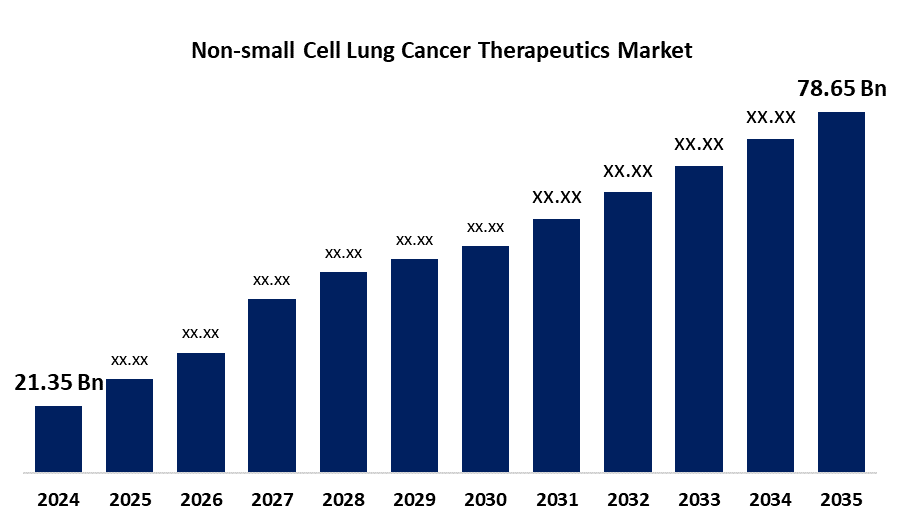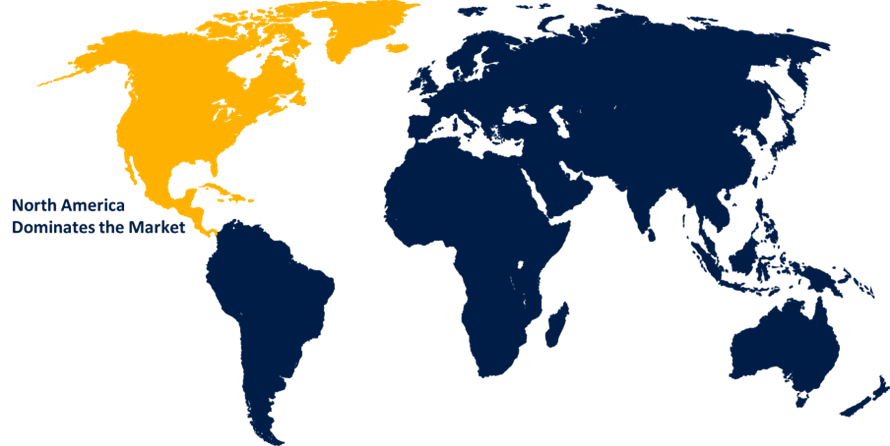Global Non-small Cell Lung Cancer Therapeutics Market Size, Share, and COVID-19 Impact Analysis, By Type (Squamous Cell Carcinoma, Large Cell Carcinoma, Adenocarcinoma, and Others), By Treatment (Chemotherapy, Targeted Therapy, Immunotherapy, and Others), By Distribution Channel (Hospital Pharmacy, Targeted Therapy, Immunotherapy, and Others), and By Region (North America, Europe, Asia-Pacific, Latin America, Middle East, and Africa), Analysis and Forecast 2025 - 2035
Industry: HealthcareGlobal Non-small Cell Lung Cancer Therapeutics Market Insights Forecasts to 2035
- The Global Non-small Cell Lung Cancer Therapeutics Market Size Was Estimated at USD 21.35 Billion in 2024
- The Market Size is Expected to Grow at a CAGR of around 12.59% from 2025 to 2035
- The Worldwide Non-small Cell Lung Cancer Therapeutics Market Size is Expected to Reach USD 78.65 Billion by 2035
- Asia Pacific is expected to grow the fastest during the forecast period.

Get more details on this report -
The global non-small cell lung cancer therapeutics market size was worth around USD 21.35 billion in 2024 and is predicted to grow to around USD 78.65 billion by 2035 with a compound annual growth rate (CAGR) of 12.59% from 2025 to 2035. The growing prevalence of lung cancer, adoption of novel therapeutics, and ongoing research & development efforts are driving the non-small cell lung cancer therapeutics market globally.
Market Overview
The non-small cell lung cancer therapeutics market is the industry encompassing the global pharmaceutical and treatment landscape for non-small cell lung cancer, the most common type of lung cancer. Non-small cell lung cancer therapeutics include a range of treatment modalities, such as surgery, chemotherapy, radiation therapy, targeted therapy, and immunotherapy. An increasing prevalence rate of lung disorders, along with the rising consumption of tobacco products, deterioration of air quality, and unhealthy lifestyles, are the factors that are escalating the non-small cell lung cancer therapeutics market. Furthermore, the increasing research and development activities and novel targeted and immunotherapy approaches are contributing to propelling the market growth.
Report Coverage
This research report categorizes the non-small cell lung cancer therapeutics market based on various segments and regions, forecasts revenue growth, and analyzes trends in each submarket. The report analyses the key growth drivers, opportunities, and challenges influencing the non-small cell lung cancer therapeutics market. Recent market developments and competitive strategies such as expansion, type launch, development, partnership, merger, and acquisition have been included to draw the competitive landscape in the market. The report strategically identifies and profiles the key market players and analyses their core competencies in each sub-segment of the non-small cell lung cancer therapeutics market.
Non-small Cell Lung Cancer Therapeutics Market Report Coverage
| Report Coverage | Details |
|---|---|
| Base Year: | 2024 |
| Market Size in 2024: | USD 21.35 Billion |
| Forecast Period: | 2025-2035 |
| Forecast Period CAGR 2025-2035 : | 12.59% |
| 2035 Value Projection: | USD 78.65 Billion |
| Historical Data for: | 2020-2023 |
| No. of Pages: | 244 |
| Tables, Charts & Figures: | 125 |
| Segments covered: | By Type, By Treatment, By Treatment, By Distribution Channel, By Region and COVID-19 Impact Analysis |
| Companies covered:: | F. Hoffmann-La Roche Ltd., Mylan N.V., Teva Pharmaceutical Industries Ltd., Sanofi, Pfizer Inc., GSK plc, Novartis AG, Bayer AG, Eli Lilly and Company, Merck & Co., Inc., Others. |
| Pitfalls & Challenges: | COVID-19 Empact, Challenge, Future, Growth, & Analysis. |
Get more details on this report -
Driving Factors
The growing prevalence of non-small cell lung cancer is contributing to driving the market. For instance, it was estimated that 85% of all lung cancers are non-small cell lung cancer in the United States. Development of personalized medicine with the growing emphasis on novel targeted therapies for the treatment of cancers, including non-small cell lung cancer, is escalating the market growth. An increasing awareness about the early diagnosis and treatment, emphasizing the removal of tumour cells, is propelling the market for non-small cell lung cancer therapeutics.
Restraining Factors
The incidence of drug resistance and competition from generics & biosimilars are restraining the non-small cell lung cancer therapeutics market. Further, the increased R&D costs and challenges in conducting clinical trials may be responsible for hampering the market growth.
Market Segmentation
The non-small cell lung cancer therapeutics market share is classified into type, treatment, and distribution channel.
- The adenocarcinoma segment dominated the market with a significant share in 2024 and is projected to grow at a substantial CAGR during the forecast period.
Based on the type, the non-small cell lung cancer therapeutics market is divided into squamous cell carcinoma, large cell carcinoma, adenocarcinoma, and others. Among these, the adenocarcinoma segment dominated the market with a significant share in 2024 and is projected to grow at a substantial CAGR during the forecast period. Treatment of adenocarcinoma includes surgery, chemotherapy, and radiation therapy. An increasing consumption of tobacco and other products of smoking is responsible for propelling the market demand in the adenocarcinoma segment.
- The targeted therapy segment accounted for a major share in 2024 and is anticipated to grow at a significant CAGR during the forecast period.
Based on the treatment, the non-small cell lung cancer therapeutics market is divided into chemotherapy, targeted therapy, immunotherapy, and others. Among these, the targeted therapy segment accounted for a major share in 2024 and is anticipated to grow at a significant CAGR during the forecast period. It includes the use of drugs that specifically target genetic mutations or pathways that drive cancer growth and spread, including tyrosine kinase inhibitors such as EGFR and ALK inhibitors. An increasing demand for better and more precise cancer therapeutics is contributing to the growth of the non-small lung cancer therapeutics market.
- The hospital pharmacy segment accounted for the largest market share in 2024 and is anticipated to grow at a significant CAGR during the forecast period.
Based on the distribution channel, the non-small cell lung cancer therapeutics market is divided into hospital pharmacy, targeted therapy, immunotherapy, and others. Among these, the hospital pharmacy segment accounted for the largest market share in 2024 and is anticipated to grow at a significant CAGR during the forecast period. Pharmaceuticals are directly purchased by hospitals and used for the treatment of either outpatients or inpatients. An increasing number of hospitalized patients suffering from NSCLC, with the growing availability of medicines and treatments, are contributing to driving the market in the hospital pharmacy segment.
Regional Segment Analysis of the Non-small Cell Lung Cancer Therapeutics Market
- North America (U.S., Canada, Mexico)
- Europe (Germany, France, U.K., Italy, Spain, Rest of Europe)
- Asia-Pacific (China, Japan, India, Rest of APAC)
- South America (Brazil and the Rest of South America)
- The Middle East and Africa (UAE, South Africa, Rest of MEA)
North America is anticipated to hold the largest share of the non-small cell lung cancer therapeutics market over the predicted timeframe.

Get more details on this report -
North America is anticipated to hold the largest share of the non-small cell lung cancer therapeutics market over the predicted timeframe. The presence of well-developed healthcare facilities, along with the rising awareness about cancer treatments, is driving the non-small cell lung cancer therapeutics market. Further, an increasing adoption of advanced immunotherapies and other critical therapies, including chemotherapy & targeted therapy in the developed countries of the region, is propelling the market growth.
Asia Pacific is expected to grow at a rapid CAGR in the non-small cell lung cancer therapeutics market during the forecast period. The increasing prevalence of lung cancer, with an increasing government investment in oncology care, is driving the regional market for non-small cell lung cancer therapeutics. Further, the factors, including environmental pollution, smoking, are responsible for propelling the non-small cell lung cancer therapeutics market.
Europe is anticipated to hold a significant share of the non-small cell lung cancer therapeutics market during the projected timeframe. The major medical institutes in the region, along with an increasing number of consumers addicted to smoking, are responsible for propelling the regional market for non-small cell lung cancer therapeutics. In addition, the availability of highly efficient drugs and demand for targeted therapies are also contributing to promoting the market.
Competitive Analysis:
The report offers the appropriate analysis of the key organizations/companies involved within the non-small cell lung cancer therapeutics market, along with a comparative evaluation primarily based on their type of offering, business overviews, geographic presence, enterprise strategies, segment market share, and SWOT analysis. The report also provides an elaborative analysis focusing on the current news and developments of the companies, which includes type development, innovations, joint ventures, partnerships, mergers & acquisitions, strategic alliances, and others. This allows for the evaluation of the overall competition within the market.
List of Key Companies
- F. Hoffmann-La Roche Ltd.
- Mylan N.V.
- Teva Pharmaceutical Industries Ltd.
- Sanofi
- Pfizer Inc.
- GSK plc
- Novartis AG
- Bayer AG
- Eli Lilly and Company
- Merck & Co., Inc.
- Others
Recent Development
- In August 2024, A supplemental new drug application (sNDA) for a first-in-class PD-1/VEGF bispecific immunotherapy agent, ivonescimab (AK112), has been granted priority review by the National Center for Drug Evaluation for the State Drug Administration of the People’s Republic of China for the frontline treatment of patients with PD-L1-positive locally advanced or metastatic non-small cell lung cancer (NSCLC).
- In October 2024, Novocure announced that the U.S. Food and Drug Administration (FDA) had approved Optune Lua for concurrent use with PD-1/PD-L1 inhibitors or docetaxel, for the treatment of adult patients with metastatic non-small cell lung cancer (mNSCLC) who have progressed on or after a platinum-based regimen.
- In March 2024, Pfizer Inc. announced longer-term follow-up results from the Phase 3 CROWN trial evaluating LORBRENA versus XALKORI in people with previously untreated, anaplastic lymphoma kinase (ALK)-positive advanced non-small cell lung cancer (NSCLC).
Key Target Audience
- Market Players
- Investors
- End-users
- Government Authorities
- Consulting And Research Firm
- Venture capitalists
- Value-Added Resellers (VARs)
Market Segment
This study forecasts revenue at global, regional, and country levels from 2020 to 2035. Spherical Insights has segmented the non-small cell lung cancer therapeutics market based on the below-mentioned segments:
Global Non-small Cell Lung Cancer Therapeutics Market, By Type
- Squamous Cell Carcinoma
- Large Cell Carcinoma
- Adenocarcinoma
- Others
Global Non-small Cell Lung Cancer Therapeutics Market, By Treatment
- Chemotherapy
- Targeted Therapy
- Immunotherapy
- Others
Global Non-small Cell Lung Cancer Therapeutics Market, By Distribution Channel
- Hospital Pharmacy
- Targeted Therapy
- Immunotherapy
- Others
Global Non-small Cell Lung Cancer Therapeutics Market, By Regional Analysis
- North America
- US
- Canada
- Mexico
- Europe
- Germany
- UK
- France
- Italy
- Spain
- Russia
- Rest of Europe
- Asia Pacific
- China
- Japan
- India
- South Korea
- Australia
- Rest of Asia Pacific
- South America
- Brazil
- Argentina
- Rest of South America
- Middle East & Africa
- UAE
- Saudi Arabia
- Qatar
- South Africa
- Rest of the Middle East & Africa
Frequently Asked Questions (FAQ)
-
1. What is the CAGR of the non-small cell lung cancer therapeutics market over the forecast period?The global non-small cell lung cancer therapeutics market is projected to expand at a CAGR of 12.59% during the forecast period.
-
2. What is the market size of the non-small cell lung cancer therapeutics market?The global non-small cell lung cancer therapeutics market size is expected to grow from USD 21.35 Billion in 2024 to USD 78.65 Billion by 2035, at a CAGR of 12.59% during the forecast period 2025-2035.
-
3. Which region holds the largest share of the non-small cell lung cancer therapeutics market?North America is anticipated to hold the largest share of the non-small cell lung cancer therapeutics market over the predicted timeframe.
Need help to buy this report?